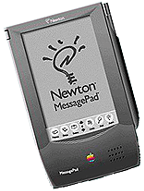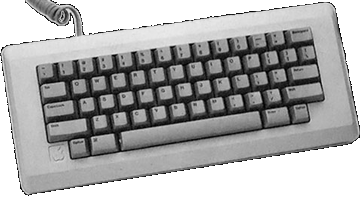Newton Message Pad (OMP)

Essentials
Family: Newton
Codename: Newton
Minimum OS: Newton OS 1.0
Maximum OS: Newton OS 1.11
Introduced: August 1993
Terminated: March 1994
Processor
CPU: ARM 610
CPU Speed: 20 MHz
FPU: none
Register Width: 32-bit
Data Bus Width: 32-bit
Address Bus Width: 32-bit
Level 1 Cache: 4 kB
ROM: 4 MB
Onboard RAM: 640 kB
Maximum RAM: 640 kB
Expansion Slots: 1 Type II PCMCIA
Video
Screen: reflective LCD
Max Resolution: 1 bit 336x240
Input/Output
Serial: 1
Speaker: mono
Networking
Modem: 9600 bps, optional
Miscellaneous
Dimensions: 7.25" H x 4.50" W x 0.75" D
Weight: 0.9 lbs.
Announced in August 1993, the Newton Message Pad was Apple's first completely new product in many years. Indeed, it represented Apple's entry into (and perhaps creation of) an entirely new market: Personal Digital Assistants (PDAs). The PDA market was barely present when the Newton was released, but other companies were working on similar devices.
The Newton Message Pad featured a variety of personal-organization applications, such as an address book, a calendar, notes, along with communications capabilities such as faxing and email. It featured a pen-based interface which used a word-based, trainable handwriting recognition engine. Unfortunately, this engine had been developed by a third party developer, and was notoriously difficult to use. While later Newton models would show improved hand-writing recognition, the Newton's reputation for poor recognition would haunt it for years to come.
The Newton ran on a 20 MHz ARM 610 processor, and used AAA batteries. It sold for $699 and was replaced in March 1994 by the Newton Message Pad 100. In October 1993, the NMP received a ROM upgrade, which patched the OS to version 1.10, which included a number of much-need bug fixes.
For much more about the Newton Message Pad, and all Newton devices, check out the Newton Gallery.
Picture Credits:
EveryMac.com
